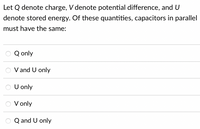
College Physics
11th Edition
ISBN: 9781305952300
Author: Raymond A. Serway, Chris Vuille
Publisher: Cengage Learning
expand_more
expand_more
format_list_bulleted
Concept explainers
Question

Transcribed Image Text:Let Q denote charge, V denote potential difference, and U
denote stored energy. Of these quantities, capacitors in parallel
must have the same:
Q only
O V and U only
O
U only
O V only
Q and U only
Expert Solution
This question has been solved!
Explore an expertly crafted, step-by-step solution for a thorough understanding of key concepts.
This is a popular solution
Trending nowThis is a popular solution!
Step by stepSolved in 2 steps

Knowledge Booster
Learn more about
Need a deep-dive on the concept behind this application? Look no further. Learn more about this topic, physics and related others by exploring similar questions and additional content below.Similar questions
- Ex. 79: Two condensers having capacitors 12 μF and 6 µF are connected in parallel. A battery of 200 V is connected across the combination. Calculate the resultant capacity and charge on each condenser. If they are connected in series, calculate the charge on each condenser and resultant capacity.arrow_forwardHow much energy must a (7.800x10^1) V battery expend to fully charge a (3.7000x10^0)x10-6 F and a (5.48x10^0)x10-6 F capacitor when they are placed in parallel? Use 3 sf and Sl units in your answer. Note: Your answer is assumed to be reduced to the highest power possible. Your Answer: x10 Answerarrow_forwardIn the figure the battery has a potential difference of V = 10.0 V and the five capacitors each have a capacitance of 9.00 uF. What is the charge on (a) capacitor 1 and (b) capacitor 2? FF (a) Number i (b) Number i Units Unitsarrow_forward
- Capacitors can be configured in a number of different geometries. Let's consider a capacitor formed by two coaxial cylinders with radii of 19.0 mm and 25.3 mm respectively and length 1.2 m. If the space between the cylinders is filled with air, find the capacitance of this configuration.arrow_forwardYou are given a box of 1000 capacitors. Each capacitor has a capacitance of 10 nF and can withstand a maximum potential difference of 5.0 V each. You are given the task of designing a network of capacitors that can with stand a potential difference of 15 V, but with an equivalent capacitance of 10 nF using only the capacitors provided. You may use as many of the capacitors (well, up to 1000..) as you need, but to save money you should use the fewest number that will meet the requirements. Sketch your network in the space below. Indicate the points at which this network would attach to the potential difference.arrow_forwardPlease help mearrow_forward
- An arrangement of capacitors is shown in the figure below. (a) If C = 7.20 ✕ 10−5 F, what is the equivalent capacitance between points a and b?F(b) A battery with a potential difference of 21.00 V is connected to a capacitor with the equivalent capacitance. What is the energy stored by this capacitor? Jarrow_forwardFor the system of four capacitors shown in the figure below, find the following. (Use C1 = 4.00 µF, C2 = 5.00 µF, C3 = 5.00 µF, and C4 = 5.00 µF for the figure.) (a) the total energy stored in the systemmJ(b) the energy stored by each capacitor C1 mJ C2 mJ C3 mJ C4 mJ (c) Compare the sum of the answers in part (b) with your result to part (a) and explain your observation.arrow_forwardFor a system of 4 capacitors shown in the figure below: Determine the following:A. The equivalent capacitance of the systemB. The charge on each capacitorC. The potential difference across each capacitorD. The stored energy in each capacitorarrow_forward
- For the system of capacitors shown in the figure below, find the following. (Let C1 = 4.00 microfarad and C2 = 8.00 microfarad.) c) the potential difference across each capacitor across C1 V across C2 V across the 6.00 µF capacitor V across the 2.00 µF capacitor Varrow_forwardConsider the following figure (a) Find the equivalent capacitance between points a and b for the group of capacitors connected as shown in the figure if C1 = 2.00 microfarad, C2 = 14.00 microfarad, and C3 = 2.00 microfarad. (b) If the potential between points a and b is 60.0 V, what charge is stored on C3?(In microcoulombs)arrow_forwardFor Problems 4-6 find the equivalent Capacitance, the Potential across Capacitor 3, and the Charge on Capacitor 4 C₁=6F 6.00 volts C₂=3F C₂ = 10 F C₁ = 14 F 4. Ceq= V3 = Q4=arrow_forward
arrow_back_ios
SEE MORE QUESTIONS
arrow_forward_ios
Recommended textbooks for you
 College PhysicsPhysicsISBN:9781305952300Author:Raymond A. Serway, Chris VuillePublisher:Cengage Learning
College PhysicsPhysicsISBN:9781305952300Author:Raymond A. Serway, Chris VuillePublisher:Cengage Learning University Physics (14th Edition)PhysicsISBN:9780133969290Author:Hugh D. Young, Roger A. FreedmanPublisher:PEARSON
University Physics (14th Edition)PhysicsISBN:9780133969290Author:Hugh D. Young, Roger A. FreedmanPublisher:PEARSON Introduction To Quantum MechanicsPhysicsISBN:9781107189638Author:Griffiths, David J., Schroeter, Darrell F.Publisher:Cambridge University Press
Introduction To Quantum MechanicsPhysicsISBN:9781107189638Author:Griffiths, David J., Schroeter, Darrell F.Publisher:Cambridge University Press Physics for Scientists and EngineersPhysicsISBN:9781337553278Author:Raymond A. Serway, John W. JewettPublisher:Cengage Learning
Physics for Scientists and EngineersPhysicsISBN:9781337553278Author:Raymond A. Serway, John W. JewettPublisher:Cengage Learning Lecture- Tutorials for Introductory AstronomyPhysicsISBN:9780321820464Author:Edward E. Prather, Tim P. Slater, Jeff P. Adams, Gina BrissendenPublisher:Addison-Wesley
Lecture- Tutorials for Introductory AstronomyPhysicsISBN:9780321820464Author:Edward E. Prather, Tim P. Slater, Jeff P. Adams, Gina BrissendenPublisher:Addison-Wesley College Physics: A Strategic Approach (4th Editio...PhysicsISBN:9780134609034Author:Randall D. Knight (Professor Emeritus), Brian Jones, Stuart FieldPublisher:PEARSON
College Physics: A Strategic Approach (4th Editio...PhysicsISBN:9780134609034Author:Randall D. Knight (Professor Emeritus), Brian Jones, Stuart FieldPublisher:PEARSON

College Physics
Physics
ISBN:9781305952300
Author:Raymond A. Serway, Chris Vuille
Publisher:Cengage Learning

University Physics (14th Edition)
Physics
ISBN:9780133969290
Author:Hugh D. Young, Roger A. Freedman
Publisher:PEARSON

Introduction To Quantum Mechanics
Physics
ISBN:9781107189638
Author:Griffiths, David J., Schroeter, Darrell F.
Publisher:Cambridge University Press

Physics for Scientists and Engineers
Physics
ISBN:9781337553278
Author:Raymond A. Serway, John W. Jewett
Publisher:Cengage Learning

Lecture- Tutorials for Introductory Astronomy
Physics
ISBN:9780321820464
Author:Edward E. Prather, Tim P. Slater, Jeff P. Adams, Gina Brissenden
Publisher:Addison-Wesley

College Physics: A Strategic Approach (4th Editio...
Physics
ISBN:9780134609034
Author:Randall D. Knight (Professor Emeritus), Brian Jones, Stuart Field
Publisher:PEARSON